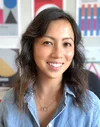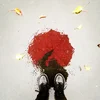Meet Cielo de la Paz, the UX lead for YouTube Create
Sep 21, 2023 [[read-time]] minute read

Sep 21, 2023 [[read-time]] minute read
For Cielo de la Paz being the design lead for YouTube Create means getting to work fulltime on her dream app. As a content creator and mobile filmmaking instructor, you’ll be hard pressed to find anyone who better understands the needs of creators more personally than her. We sat down with Cielo to talk about her path to YouTube, how she foresees YouTube Create bringing more diverse voices into the creation space, and how innovations in AI are changing the ways creators work.

In 2015, Apple reached out to me after seeing my work online. They asked to use my photos and video for their "Shot on iPhone" ad campaign. I immediately had family and friends asking me for advice on how to take better photos and videos with their phones so to be more efficient, I created a Skillshare course on making videos with your phone, and directed people to the course with any questions.

At the same time, Stanford was looking for an instructor to teach a course on the same topic, saw my Skillshare course, and reached out to me to create and teach a course for them.
One quarter, one of my students was the Product Director for YouTube Create. After the course was over, he connected with me on LinkedIn and learned that I was a design lead. Coincidentally, he was looking for a design lead for his team, and he thought I would be a perfect fit. I agreed, and I’ve been leading design on YouTube Create ever since.
“I’m a creator and for the longest time, what was missing from this equation was the ability to easily edit videos on the phone without having to be a professional editor.”
Mobile filmmaking has come a long way in recent years. Back in 2015, I used my phone to film videos mainly for convenience, but I had to sacrifice quality for that convenience. Today, the quality of video that can be captured on a mobile phone has increased exponentially, and there is a wide range of specialized gear available for mobile filmmaking.
However, the real game-changer has been the development of powerful video editing software for mobile phones. From professional filmmaking apps like Filmic Pro to fun platforms like YouTube Shorts, there are now tools for almost everything you can imagine
I’m a creator and for the longest time, what was missing from this equation was the ability to easily edit videos on the phone without having to be a professional editor. That’s what was so exciting when we first set out to build the YouTube Create app. It honestly felt like I was getting to create my dream app for video editing. I’m looking forward to other creators having their production process streamlined and made easier. For new creators out there who may have felt like a lack of editing knowledge was their barrier to entry, I’m hoping this removes a barrier that will lead to even more content creation.
“With all the creator feedback and my own experience, YouTube Create is an app designed by and for creators.”
My experience as a creator definitely played a role in how I approached the project but we also consulted over 3000 creators globally about the features that mattered most to them and to get their feedback.
Initially when I joined the team, I was a bit conflicted because as User Experience (UX) designers, we're taught that "you are not your users." But as we ran our biweekly user research sessions, I started to hear the exact same things from the creators we interviewed that I instinctively knew so I began to trust that my personal experience as a user is of value and I needed to break from that mantra to be effective in my role.
Once I got over this hurdle, it was easier to trust my intuition to make design decisions. For example, deciding how the elements on a timeline should behave in relation to each other is a complex task, and it can be difficult to create a prototype that accurately reflects their behavior for user testing. As a creator, I could advocate for features that I knew were essential for a good editing experience, such as the ability to zoom in all the way down to the frame for precision editing (a major pet peeve of mine with other editing apps), as well as a large library of assets such as transitions, text styles, and stickers. I also advocated for smaller features that make a big difference, like displaying the duration of clips and allowing users to edit text in a specific order.
With all the creator feedback and my own experience, YouTube Create is an app designed by and for creators.
“Generative AI is already changing how creators work, and we need to push the boundaries of innovation to think beyond what's possible today. We need to ask ourselves, "What if editing didn't have to be done the traditional way? What would that look like?" ”
Generative AI is already changing how creators work, and we need to push the boundaries of innovation to think beyond what's possible today. We need to ask ourselves, "What if editing didn't have to be done the traditional way? What would that look like?" With generative AI, we can solve creators' pain points in much more creative ways than before because we can do things like create new assets to fill in the gaps.
For example, creators often say that it can take them hours to find the right song for their video. Without generative AI, the solution would be something like offering personalized recommendations using an algorithm. But with generative AI, we can solve for that in a much more creative way.
We are definitely going to deliver more than just “faster horses” because of how we can innovate with AI.
Lots of memes, gifs, and hilarious videos shared in our team chat paired with belief, collaboration, and trust. Everyone involved, from Susan Wojcicki’s early support, to the support from Neal Mohan and his leadership team, the partner teams who helped us develop the underlying platform, the teams who created assets like stickers, text effects, music effects, and the go-to-market team who helped put the app in creators' hands, had to believe in the app's potential.
As for the small core team, we all really believe in this app. So much care and hard work has gone into it. So that we could move fast, we were empowered and trusted to independently make decisions without much process and oversight and given grace if we stumbled. It really felt like being at a startup in some ways. Additionally, the team equally valued and respected input from all team members. Product managers listened to UX input on product feature priorities, UX listened to engineers on interaction, and we all valued each other's perspectives. This led to us delivering more than we even thought possible.
User research played a huge role in the development of this app. Our fantastic user research lead, Galen Panger, set up an aggressive program that the whole team supported because we believed in the value of research. As I mentioned, we spoke to over 3000 creators globally. We had a cadence of doing user research studies every two weeks, and these studies often involved a prototype that creators could interact with.
The whole team contributed to the success of our research program. It wasn't just the UX team's responsibility. Our product managers built research into timelines, engineers set time aside to enable features for testing, and product managers, engineers, and UX designers were all present for the individual research sessions with creators and findings readouts. There was no need to convince anyone that something had to be done or changed, because we were all aware of the findings.

I hope creators appreciate the ease and simplicity of using the timeline. We added playfulness along with function, and I think they'll like the creative ingredients we offer, especially the large free audio library.
I'm partial to music myself, so I love our "Find beats" feature. It generates the beats in your music and snaps the clips on your timeline to the beat markers as you trim them, making it easy to create a well-timed video.
This is just the beginning of the app, though. There's a lot more to come that I know creators will be very excited about.
At the very least, I hope that we make creation accessible to more people, empower new creators, and hear from more diverse voices. More voices means more people will feel represented and seen. This is really important to me, especially myself being a minority in many ways – being a Filipino woman in tech, I’m not the most represented segment. As for transforming mobile filmmaking, we are asking the right questions. We are questioning the traditional way of doing things: Do they still have to be done that way? We are asking, how can we reduce the pain points of creation and increase creativity? I believe that asking these questions will lead to new and innovative ways to make and share videos, potentially creating new methods and processes of creation and that’s a really exciting prospect for the future of content creation.